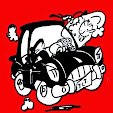Wednesday, 22 February 2017
Review The Wild Party
The Wild Party
Music and Lyrics by Michael John LaChiusa
Book by Michael John LaChiusa and George C Wolfe
The Ballad of Queenie
https://www.theotherpalace.co.uk/
Have you had the invite, strictly word-of-mouth of course, to the party Queenie and her boyfriend Burrs' apartment? The Wild Party, the musical was first performed on Broadway in 2000 and now arrives in London to flaunt its wares.
Queenie (Frances Ruffelle) and Burrs (John Owen-Jones) are vaudeville entertainers: she is a chorus girl, he is a clown with a neat line in Al Jolson-like crooning in another act. They have a stormy relationship, but once in a while draw together to have a party for their ne'er-do-well friends and acquaintances.
It may be the time of Prohibition, but the gin flows liberally in the bathtub and there's a host of guests sprawled around to enjoy the hospitality - and the cocaine. Guests include faded diva Delores (Donna McKechnie) and Queenie's rival Kate (Victoria Hamilton-Barritt) with whom she has a love-hate relationship. Dissolute playboy Jackie (Dex Lee), who swings both ways and sibling dance act Phil and Oscar D'Amano, sexually ambiguous in more ways than one (Gloria Obianyo and Genesis Lynea).
Directed and choreographed by Drew McOnie, the show is divided into five parts - the original Broadway production had vaudevillian placards to emphasize this was a kind of Chorine's Progress. The set, designed by Soutra Gilmour, is a shabby-chic dark red and black speakeasy with an arc of bulbs, as on a dressing room mrror, stretching from the orchestra on the second storey to the floor below.
The musical is based on a racy 1926 poem by Joseph Moncure March, written in the style of a folk ballad with jazz-like inflections and its own choppy publication history - it only found a publisher two years later and was banned in Boston.
It then fell into obscurity and eventually the public domain. It re-emerged in the 1990s when cartoonist Art Spiegelman created new illustrations and a fresh edition was published.
Frances Ruffelle is a feisty, voracious but vulnerable Queenie in her relationship with the almost Bill Sikes-like John Owen-Jones's Burrs. Yet we did feel that once all the characters are established for the audience there is nowhere for them to go. The poem has a slight predictable plot, playing on sometimes crude stereotypes and low life but makes up in style and possible metaphor what it lacks in a compelling Beggars' Opera story. However the musical does nothing to remedy the plot deficiencies.
The wildness of the party has a way of outstaying its welcome without advancing the plot. Perhaps it was a mistake to strip the show of the vaudeville/silent film placards. Whatever, the jazz age-inflected songs tend to merge into one with honourable exceptions such as Welcome To My Party and the embodiment of Queenie and Kate's spikey relationship Best Friend.
Still, the choreography is thrilling and there are some fine individual performances (the interpretation of the D'Amano Brothers is inspired). It's an amber light for a perfectly solid, if not flawless, beginning at the re-branded The Other Palace.
Subscribe to:
Post Comments (Atom)





No comments:
Post a Comment